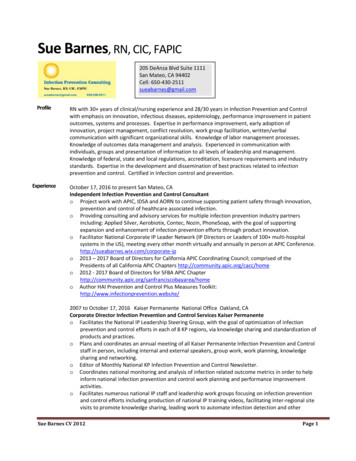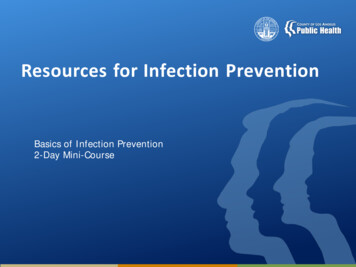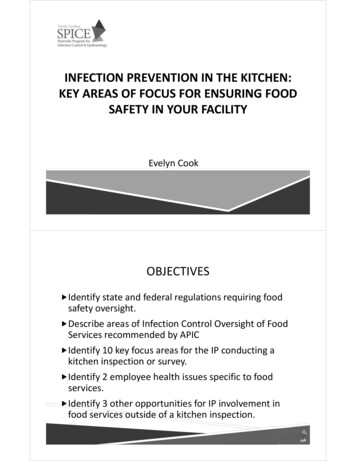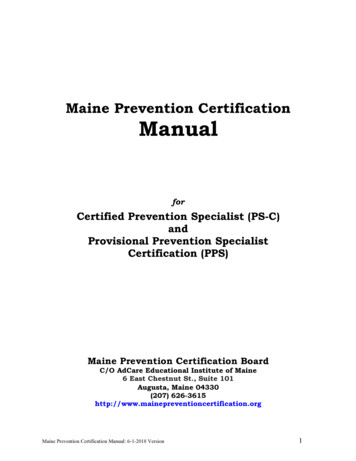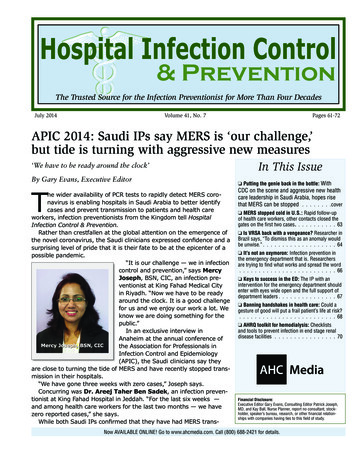
Transcription
& PreventionThe Trusted Source for the Infection Preventionist for More Than Four DecadesJuly 2014Volume 41, No. 7Pages 61-72APIC 2014: Saudi IPs say MERS is ‘our challenge,’but tide is turning with aggressive new measures‘We have to be ready around the clock’By Gary Evans, Executive EditorThe wider availability of PCR tests to rapidly detect MERS coronavirus is enabling hospitals in Saudi Arabia to better identifycases and prevent transmission to patients and health careworkers, infection preventionists from the Kingdom tell HospitalInfection Control & Prevention.Rather than crestfallen at the global attention on the emergence ofthe novel coronavirus, the Saudi clinicians expressed confidence and asurprising level of pride that it is their fate to be at the epicenter of apossible pandemic.“It is our challenge — we in infectioncontrol and prevention,” says MercyJoseph, BSN, CIC, an infection preventionist at King Fahad Medical Cityin Riyadh. “Now we have to be readyaround the clock. It is a good challengefor us and we enjoy our work a lot. Weknow we are doing something for thepublic.”In an exclusive interview inAnaheim at the annual conference ofthe Association for Professionals inInfection Control and Epidemiology(APIC), the Saudi clinicians say theyare close to turning the tide of MERS and have recently stopped transmission in their hospitals.“We have gone three weeks with zero cases,” Joseph says.Concurring was Dr. Areej Taher Ben Sadek, an infection preventionist at King Fahad Hospital in Jeddah. “For the last six weeks —and among health care workers for the last two months — we havezero reported cases,” she says.While both Saudi IPs confirmed that they have had MERS trans-In This Issueo Putting the genie back in the bottle: WithCDC on the scene and aggressive new healthcare leadership in Saudi Arabia, hopes risethat MERS can be stopped covero MERS stopped cold in U.S.: Rapid follow-upof health care workers, other contacts closed thegates on the first two cases. 63o Is VRSA back with a vengeance? Researcher inBrazil says, “To dismiss this as an anomaly wouldbe unwise.” 64o It’s not an oxymoron: Infection prevention inthe emergency department that is. Researchersare trying to find what works and spread the word 66o Keys to success in the ED: The IP with anintervention for the emergency department shouldenter with eyes wide open and the full support ofdepartment leaders 67o Banning handshakes in health care: Could agesture of good will put a frail patient’s life at risk? 68o AHRQ toolkit for hemodialysis: Checklistsand tools to prevent infection in end stage renaldisease facilities 70Financial Disclosure:Executive Editor Gary Evans, Consulting Editor Patrick Joseph,MD, and Kay Ball, Nurse Planner, report no consultant, stockholder, speaker’s bureau, research, or other financial relationships with companies having ties to this field of study.Now AVAILABLE ONLINE! Go to www.ahcmedia.com. Call (800) 688-2421 for details.
mission in the past to patients and health careworkers, one of the key differences now is wideravailability of PCR tests that can confirm or ruleout MERS in no more than six hours.“That is really helping us manage the cases,”Joseph says. “The lab is one of the main centerpoints of our care. Even at night, we have goodcommunication and they will call us without fail.”Delays in getting confirmed test results havelikely led to unprotected exposures to patientsand health care workers, says Fiaz Ahamed,MD, MBBS, infection preventionist at Al RassGeneral Hospital.“Before there was only one center in one citywhere they were testing,” he says. “Now thereare many [testing] centers and they are implementing efficient specimen test protocols to guarantee the validity of tests.”Asked about reported1 breakdowns in infectioncontrol in Saudi hospitals, Ahamed says failure tofollow all precautions for unconfirmed cases hasbeen part of the problem.“Sometimes there are breaches in infectioncontrol strategies — they may have not beenwearing masks or something,” he tells HIC.“Actually, the infection control programs are verystrong in Saudi Arabia. Once the patient is confirmed there is 100% infection control.”But exposures may occur from suspect patientsbecause until recently, test results may not havebeen available for 2 to 3 days at many hospitals. “Confirmed cases are placed under isolationthat includes negative pressure air ventilation,”Ahamed says. “But only the confirmed cases arethere, and the suspect cases during this timeperiod could be a source of infection.”The threat to health care workersCertified in infection control since 2006, Josephsays anyone who comes to her hospital withflu-like symptoms is immediately separated intoanother area and tested for MERS. “There is nomixing and mingling — we have a really good triage system,” she says.The hospital has seen transmission to healthcare workers from unsuspected cases, particularlyone who did not show any obvious signs of MERs.“He was not even suspected [as having MERS]and that was the reason he exposed a lot ofhealth care workers,” Joseph says. “Only afteradmission was it suspected, and by that timesome employees were exposed.”Another health care worker infected a colleaguebecause the two shared a small apartment, shesays. It is estimated that a quarter of MERScases have been in health care workers, but thevast majority of fatal infections have occurred inpatients with chronic underlying conditions.Hospital Infection Control & Prevention , including Infection Control Consultant and Healthcare Infection Prevention (ISSN 0098-180X), is published monthly by AHC Media, LLC,One Atlanta Plaza, 950 East Paces Ferry NE, Atlanta, GA 30326. Telephone: (404) 262-7436. Periodicals Postage Paid at Atlanta, GA 30304 and at additional mailing offices.Web: www.ahcmedia.comPOSTMASTER: Send address changes to Hospital Infection Control & Prevention , P.O. Box 550669, Atlanta, GA 30355.AHC Media is accredited as a provider of continuing nursing education by the American Nurses Credentialing Center’s Commission on Accreditation.This activity has been approved for 15 nursing contact hours using a 60-minute contact hour.Provider approved by the California Board of Registered Nursing, Provider #14749, for 15 Contact Hours.AHC Media is accredited by the Accreditation Council for Continuing Medical Education to provide continuing medical education for physicians.AHC Media designates this enduring material for a maximum of 18 AMA PRA Category 1 Credits . Physicians should only claim credit commensurate with the extent of theirparticipation in the activity.This activity is effective for 36 months from the date of publication.Target audience: Infection control practitioners and infectious disease physicians.Opinions expressed are not necessarily those of this publication. Mention of products or services does not constitute endorsement. Clinical,legal, tax, and other comments are offered for general guidance only; professional counsel should be sought for specific situations.Executive Editor: Gary Evans, (706) 310-1754, (gary.evans@ahcmedia.com).Production Editor: Kristen Ramsey.Continuing Education and Editorial Director: Lee Landenberger.Copyright 2014 by AHC Media. Hospital Infection Control & Prevention and Infection Control Consultant are trademarks of AHC Media.The trademarks Hospital Infection Control & Prevention and Infection Control Consultant are used herein under license. All rights reserved.Editorial QuestionsFor questions or comments, callGary Evans at (706) 310-1754.Subscriber InformationCustomer Service: (800) 688-2421 or fax (800) 284-3291. Hours of operation: 8:30-6. Monday-Thursday, 8:30-4:30 Friday EST. World Wide Web: http://www.ahcmedia.com.E-mail: customerservice@ahcmedia.com.Subscription rates: U.S.A., Print: 1 year with free AMA PRA Category 1 creditsTM or Nursing Contact Hours(12 issues), 499. Add 19.99 for shipping & handling. Online only, singleuser: 1 year with free AMA PRA Category 1 creditsTM or Nursing Contact Hours, 449. Outside U.S., add 30 per year, total prepaid in U.S. funds. Discounts are available for groupsubscriptions, multiple copies, site-licenses or electronic distribution. For pricing information, call Tria Kreutzer at 404-262-5482. Missing issues will be fulfilled by customer service freeof charge when contacted within one month of the missing issue date. Back issues, when available, are 78 each. (GST registration number R128870672.)Photocopying: No part of this newsletter may be reproduced in any form or incorporated into any information retrieval system without the written permission of the copyright owner. Forreprint permission, please contact AHC Media. Address: P.O. Box 550669, Atlanta, GA 30355. Telephone: (800) 688-2421.62Hospital Infection Control & Prevention / July 2014
Rapid follow-up, no MERS spread in two U.S. casesCDC: ‘We will continue to err on the side of caution’None of the health care workers or otherpeople exposed to the first two MERScases in the United States were infected, ascontacts were subject to rapid follow up andhome quarantine policies following the exposures.For example, in the hours before MERS wassuspected in the second U.S. case in Orlando,several employees in the emergency department at Dr. P. Phillips Hospital had unprotected exposures.With the help of nurse managers, the hospital quickly identified those exposed employees, says Ken Michaels, MD, MPH, medicaldirector of occupational health at OrlandoHealth, the parent health system. Two physicians and 14 employees at Dr. P. PhillipsHospital were placed on home isolation for 14days. Another six employees and one physician at Orlando Regional Medical Center werefurloughed after it was discovered they wereexposed when the patient accompanied afriend to the radiology department there.Daily phone calls to exposed employeeshelped assuage fears, and use of a mobileoccupational health clinic at the hospitalmade testing quick and convenient, Michaels“We had a few cases of health care workersbecoming infected, but they are all fine now,”Joseph says.The first two MERS cases in the U.S. werehealth care workers who traveled from SaudiArabia, drawing attention to the large number ofworkers from other nations who provide medicalcare in the Kingdom. (See related story, above.)63.) Health care workers who travel from SaudiArabia to other nations should be aware of anysigns and symptoms of MERS, which has an incubation period for as long as two weeks, Josephsays.“We know the main important factor is to givethem more education,” she says. “We tell themif you are leaving this country you have to selfobserve for yourself. Even us coming here, we arealso exposed to the patients, so we have to do theproper precautions and self-observe.”July 2014 / Hospital Infection Control & Prevention says.“We wanted to make sure they had anavenue to ask questions, to be heard,” saysMichaels, who personally called each furloughed employee every day to ask about anysymptoms and to respond to any concerns. “Ireally think that made a tremendous difference. It was very reassuring for them.”The Florida MERS case was confirmed onMay 11, 2014, about a week after the firstU.S. imported case of MERS was confirmedin Illinois. Both men had recently worked inhospitals in Saudi Arabia. The CDC initiallyreported the Illinois man transmitted MERSto a business associate from Indiana, butreversed the call after more definitive testing.“While we never want to cause undueconcern among those who have had contactwith a MERS patient, it’s our job to movequickly when there’s a potential public healththreat,” says David Swerdlow, MD, theCDC’s incident manager for MERS response.“Understand that the situation is very fluidand our information may change. Becausethere is still much we don’t know about thisvirus, we will continue to err on the side ofcaution.” nSome Saudi hospitals are giving incentives likesalary supplements to health care workers willingto work with MERS patients, Ahamed says. “But ifI am a physician or health care worker and I follow the complete measures of prevention I will behappy to work there. If you follow these measuresthere is no harm in working.”Al Rass is some 400 miles away from wheremost cases have been occurring, and thus farAhamed has primarily dealt with suspect cases.“In my hospital we have had 15 suspect cases,but none of them became positive,” he says. “ButI do visit hospitals where there are some [MERS]patients. I do rounds and I have been with themand their infection control practitioners.”Though Ahamed did not want to get intohealth policy matters, many of the initiatives andchanges described by the Saudi IPs have comerecently under the new leadership of health min63
ister Adel bin Mohammad Faqih. The change hasresulted in more transparency and the case countand mortality figures were revised upward aftera review of all cases since the outbreak began in2012. As of June 4, 2014 there were 695 MERScases and 283 deaths in Saudi Arabia. Other newinitiatives under Faqih include an electronic casereporting system, guidelines for the proper labeling and storage of samples in hospitals and labs,protocols to ensure the integrity of samples duringtransport, and a courier transportation system forrapid transfer of specimens.“Our country has a lot of resources and all thecontrol measures are being provided,” Ahamedsays.Mutable MERS lacks pandemic punchWhile a deadly threat to immune compromisedpatients in hospitals, MERS has not been able tosustain transmission in the community beyond afew reports of families and other close contacts.Many uncounted mild or asymptomatic cases mayhave occurred, but transmission seems to rapidlydissipate in the community. In the absence of amutation making it more transmissible — whichis certainly a realistic concern given the knownmutability of coronaviruses — MERS currentlylacks the staying power needed for true pandemicpotential.Last year, for example, researchers comparedMERS to SARS using the classic epidemiologicalmeasure of reproductive ratio, the expected number of secondary infections from a single case.The reproductive ratio reaches a tipping pointfor further transmission at 1 or above, indicating secondary infections can sustain an outbreak.Researchers looked at 55 laboratory-confirmedcases of MERS, finding that even in their most“pessimistic scenario,” that MERS had a reproductive ratio of .69. They noted that pre-pandemicSARS was in the .80 range, but that coronavirusdid apparently mutate and become more transmissible at some point in the outbreak.2 That possibility remains with MERS, which has apparentlyestablished a reservoir in camels in the regionafter likely emerging as a bat-borne virus.Some Saudi Clinicians are trying to treatMERS cases with an experimental combination ofribavirin and interferon, Ahamed notes. The drugcombination had some success against SARS, butthe results with MERS have been inconclusive.“[Overall,] the case fatality rate is about 40%for the confirmed cases,” Ahamed says.64The emergence ofMERS has led to a dramatic culture changein Saudi Arabia, as theIPs say that people arewashing their handsmuch more frequentlyin public settings.“In the schools, themalls, in the Mosques,everywhere now wehave [hand hygiene],”says Ben Sadek. “Iwent to my daughter’sschool and they are asked, ‘Please you are a doctor can you give us some education?’ I told themit is not just MERS. It could be meningitis, the flu,we just need to apply hygiene and standard precautions to everything in our lives. Even at home— hand hygiene.”REFERENCE1. World Health Organization: WHO concludes MERS-CoVmission in Saudi Arabia. May 7, 2014: http://bit.ly/1fP2kF62. Breban R, Riou J, Fontanet A. Interhuman transmissibilityof Middle East respiratory syndrome coronavirus: Estimationof pandemic risk. Lancet Early Online Publication, 5 July2013 doi:10.1016/S0140-6736(13)61492 nA bug in Brazil: Is VRSAback with a vengeance?‘To dismiss this as an anomaly would be unwise’Though the health care continuum is currentlyunder siege by a host of emerging gramnegatives like CRE, at one time a much-fearedsingle pathogen was thought to herald the arrivalof the post-antibiotic era: Vancomycin-resistantStaphylococcus aureus (VRSA).Sporadic cases of VRSA eventually occurred inthe U.S., as MRSA infections appeared that wereimpervious to vancomycin — the mainstay drugagainst resistant staph strains for decades. Butthe vaunted superbug was not able to sustainitself and establish an endemic presence in hospitals or communities. Some theorized that theprice of greater drug resistance in the microorganism was the loss of vigor and transmissibility,and the VRSA threat was largely forgotten.Now we have this — an alarm blinking inBrazil, warning that VRSA is back and showing true threat potential. In answer to our firstHospital Infection Control & Prevention / July 2014
skeptical questionabout the finding,lead researcherCesar Arias, MD,PhD, says, “Todismiss this as ananomaly would beunwise.”A professor of medicineand moleculargenetics at theHouston-basedUniversity of TexasHealth ScienceCenter, Arias andcolleagues conducted microbiological and genetic analyses ofVRSA recovered from the blood of a 35-year-oldBrazilian man. They identified a novel transferable plasmid that carries the genes necessary forvancomycin resistance. As noted in the case summary below, the VRSA isolate has genetic links tothe widespread USA300 community strain and itsvanA cluster plasmid could be easily transferred— and presumably confer resistance — to otherstaph strains.“We report the case of a patient from Brazilwith a bloodstream infection caused by a strainof methicillin-resistant Staphylococcus aureus(MRSA) that was susceptible to vancomycin butthat acquired the vanA gene cluster during antibiotic therapy and became resistant to vancomycin,” the authors reported.1 “Both strains are phylogenetically related to MRSA lineage USA300.A conjugative plasmid carrying the vanA clusterwas identified and readily transferred to otherstaphylococci. The presence and disseminationof community-associated MRSA containing vanAcould become a serious public health concern.”Two points jump out immediately from thissummation — the potential for VRSA in the widelydispersed MRSA USA300 community strain, andthe fact that the patient had a bloodstream infection instead of the soft tissue infections typical forVRSA.“This is the first-ever reported bloodstreaminfection caused by a highly vancomycin-resistantMRSA bacteria,” Arias says. “The fact that thiswas acquired as a bloodstream infection raisesthe question, has this bug now adapted and is itmore able to carry these genetic resistance traits?We don’t know how widespread this plasmid is inBrazil.”July 2014 / Hospital Infection Control & Prevention The patient had a history of leg cellulitis andwas admitted to a hospital in June 2012 withrecurrent infections of the skin and soft tissues.Vancomycin and other antibiotics were usedto treat recurrent symptoms while the patientremained in the hospital for treatment of skincancer. On July 16 and 24, blood cultures yieldedMRSA isolates that were susceptible to vancomycin, linezolid, and clindamycin. On August 15,however, fever recurred and blood cultures werepositive for two MRSA isolates, one of which wasresistant to vancomycin (minimal inhibitory concentration, 32 μg per milliliter).“This is a bloodstream infection coming straightfrom the soft tissue infection with the ability tocause severe infection in this case,” Arias says.“So this is behaving as staph behaves, the acquisition of these [resistance components] did notappear to cause any problems in its pathogenicability.”‘This strain is different’Much like many of the first cases of VRSA, vancomycin resistance may have been transferred bya co-infecting vancomycin resistant enterococci(VRE) strain.“It is possible the transposon that carried theresistance gene came from enterococci becausewe compared the sequence of the transposon — tis identical to the VRE that we isolated from thepatient,” Arias says. “However, the plasmid —which is the one that is carrying this transposon— it is not an enterococcal plasmid. This plasmidseems to be able to go into any staph and thatcould cause problems.”Given the genetic lineage identified, that wouldapparently include the USA300 community strain,which arose dramatically in the 1990s and hasnow displaced less hardy MRSA varieties in boththe community and hospitals. In short, the storyof VRSA is far from over.“I don’t think so,” Arias says. “Strains of VRSAhave now popped up in the United states, inEurope, India, Iran and now in South America.Now it is true that there is no evidence that it hasdisseminated, but this strain is different from theothers. The difference is that this strain is now ina genetic background that has previously beenshown to be easily spread. This community-associated MRSA USA300 has become epidemic in theU.S. and also in South America. It has actuallyentered hospitals.”A USA300 strain of VRSA would certainly65
threaten hospital patients, but given its community origins could also cause infections in healthypeople.“The worst resistance possible has nowappeared in [a] community-associated MRSAclone,” says Barbara Murray, MD, co-authorof the paper and director of the Division ofInfectious Diseases at the UTHealth MedicalSchool. “There will have to be increased surveillance in South America and worldwide in thefuture.”There are a few other possible drug options(i.e.,linezolid) against VRSA.“We have options, but the problem is theoptions are more expensive — we will be hardpressed to find [options] equivalent to vancomycin,” says Arias, the founder and scientific director of the Molecular Genetics and AntimicrobialResistance Unit at Universidad El Bosque inBogota, Colombia.The VRSA isolate in this case was also resistant to teicoplanin, erythromycin, clindamycin,ciprofloxacin, gentamicin, and trimethoprim–sulfamethoxazole. Beset with other infections,including carbapenem-resistant Acinetobacterbaumannii, the Brazilian patient died in November2012. The patient died while receiving meropenem, linezolid, polymyxin B sulfate, and amphotericin B.Reference1. Rossi F, Diaz L, Wollam A, et al. Transferablevancomycin resistance in a community-associatedMRSA lineage. N Engl J Med 370;16:1524-1531 nAPIC 2014: Infectionprevention in the ED‘Being fast will save someone’s life.’As the “front door of the hospital” to bothpatients and pathogens, the emergencydepartment (ED) is a critical setting for infectionprevention that has a unique and often poorlyunderstood work culture. As a result, infectionprevention projects can quickly run aground ifundertaken with the typical approaches usedfor other patient settings, a leading emergencymedicine researcher told a packed audiencerecently in Anaheim at the annual conferenceof the Association for Professionals in InfectionControl and Epidemiology (APIC).66‘I think it’s important for everyone in this roomto look at the work environment of the ED,”says Jeremiah Schuur, MD, director of Quality,Patient Safety and Performance Improvementfor Emergency Medicine at the Brigham andWomen’s Hospital in Boston. “You go into workand your job is to take care of everybody thatshows up as quickly as possible and you don’t getlot of [patient] information. There’s a huge pressure on being fast, because being fast will savesomeone’s life. It may not be everybody’s life, butif you are not fast there is going to be someone inthe waiting room who is there too long.”Schuur described a work force of committedprofessionals who nonetheless may cut cornerson measures like personal protective equipment(PPE), an all too common problem that was citedby an infection preventionist in the audience.“We deprioritize (PPE) and it’s a challenge,”Schuur said. “People do that because in order todo your job sometimes you can’t take every step.You can’t put on precautions for every patientwho has influenza-like illness, because at certaintimes of the year that would be one in every fourpatients and that would take all of the time wehave.”Instead of the typical inservice approach,emergency medicine workers respond better tostories and personal narratives that embody theimportance of infection prevention in the chaoticsetting, he added. These stories particularly resonate with ED workers if told by a member of theirteam or by someone who has worked in emergency medicine, he said.“I really can’t emphasize the importance of thisenough,” he said. “This has to be the emergencydepartment’s initiative to get their support. Asmuch as anything else, if it is not something theED is really championing themselves it is going tofail.”For example, hand hygiene complianceimproved considerably at one ED when an emergency nurse returned to work after being treatedfor breast cancer. “She [repeatedly] told her storyabout having been neutropenic and having tofear every person who came into the room whenshe was getting chemotherapy,” Schuur told APICattendees.By the same token, IPs should enlist an EDchampion to support an intervention, makingsure the data generated is actionable, relevant tothe setting, and promptly reported back. “Are youasking people to do things that are going to takefive extra steps, which is going to make it imposHospital Infection Control & Prevention / July 2014
Key strategies to improve ED infection preventionResearchers on improving infection prevention in the emergency departmentrecently recommended the general strategiesbelow in Anaheim at the annual conference ofthe Association for Professionals in InfectionControl and Epidemiology. The comments arefrom interviews they conducted during theirproject.Leadership Support: Hospital, ED, keyconsult services (e.g., trauma) Helps to set expectations Necessary to secure funds and resourcesfor initiative. Gain the support of leadership“He got onboard and once he got onboardhe was just a train. He’s a big train when itcomes to infection [prevention], everything inthe hospital when it comes to infections. He’svery supportive in giving us what we need.”RN educatorData Collection and Feedback Post data on flyers in the staff lounge orinclude in the ED newsletterStaff Engagement Include staff on multidisciplinary committeessible for them to do their jobs efficiently? [Thatis] ultimately going to undermine compliance,” hesaid.Schuur is one of the principal investigators inan ongoing project to identify successful infectionprevention interventions in hospital emergencydepartments. He has received funding from theAgency for Healthcare Research and Quality toidentify infection control practices that have beensuccessfully implemented by EDs.A key portal for infection control“I would make the case that the emergencydepartment is a key portal for infection prevention,” he told APIC attendees. “There are about130 million [patient] visits every year. It [varies] hospital to hospital, but overall, nationwidehalf of the admissions [come through the ED].Over 2 million ICU admissions, and we place lotsof devices which are then at risk for infection —central lines, urinary catheters and intubation.”The patient population is widely diverse, sufJuly 2014 / Hospital Infection Control & Prevention Champions Develop program cheerleaders (selfidentified or chosen by management orleadership) Have devoted interdisciplinary championsas noted by this ED Chairman:“If you don’t have a shepherd it doesn’thappen. It doesn’t have to be a physician,it really doesn’t. It has to be an interestedchampion who is willing to take the messageto the streets, recognize that there are manydifferent streets. You’ve got the attendings,the nurses, whoever.”Build Environment Modifications Ask staff “What are the structural barriers to compliance?” Great way to encouragethe participation of frontline workersStaff Training Make training a part of annual educationand competencies Train new hiresWorkflow Modifications Make it easy for staff to comply withworkflow modifications nfering from various maladies in very close proximity.“Sometimes they are separated by curtains,a hallway and sometimes nothing,” he said. “Sothere is a real obvious chance for there to betransmission. We may have someone who is onchemotherapy, someone who is neutropenic,someone from a skilled care facility who has amultidrug resistant organism.“ED staff vary from doctors and nurses to security staff, translators, and technicians who mayhave little medical training. The overriding primemission of emergency medicine — the life-savingemergencies where seconds and minutes matter— actually occurs only about 5% to 10% of thetime one works in the ED, Schuur said.“But working in that situation engenders a certain acceptability or normalization of deviance,”he said. “[The thinking is] if it’s OK to break rulesin that situation, you might be able to do it inmore situations. And so our culture prioritizesurgent intervention over refection — we valuedecisive action over circumspection.”67
Chronic crowding in many EDs certainly fuelsthat type of mindset, as workers often haveinsufficient space and manpower to provide thebest care, he adds. ICU beds are rarely availablewithin an hour and breakdowns in communicationabout “where the patient is from and where arethey going” are far too common. “All of these willaffect your ability to provide safe care and infection prevention,” he said.Another undermining factor is “goal conflicts”that ED workers use to rationalize non-compliance. “Wh
One Atlanta Plaza, 950 East Paces Ferry NE, Atlanta, GA 30326. Telephone: (404) 262-7436. Periodicals Postage Paid at Atlanta, GA 30304 and at additional mailing offices. Web: www.ahcmedia.com POSTMASTER: Send address changes to Hospital Infection Control & Prevention , P.O. Box 550669, Atlanta, GA 30355.

